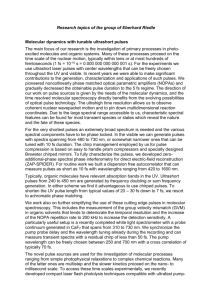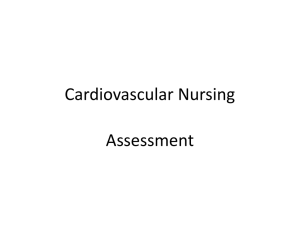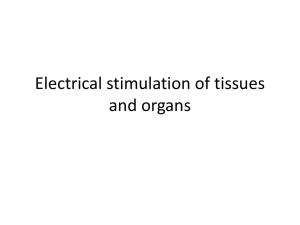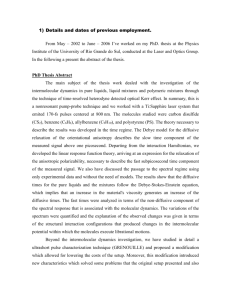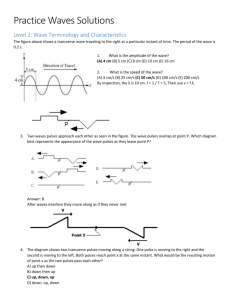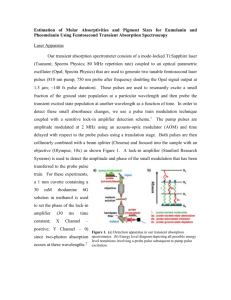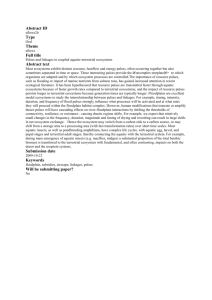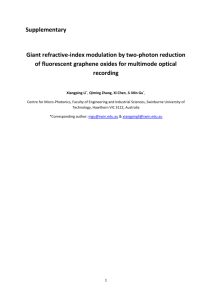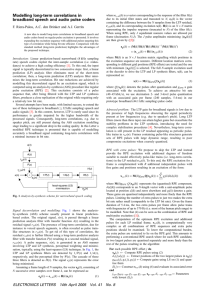kT PINS RF pulses for low power field inhomogeneity compensated
advertisement
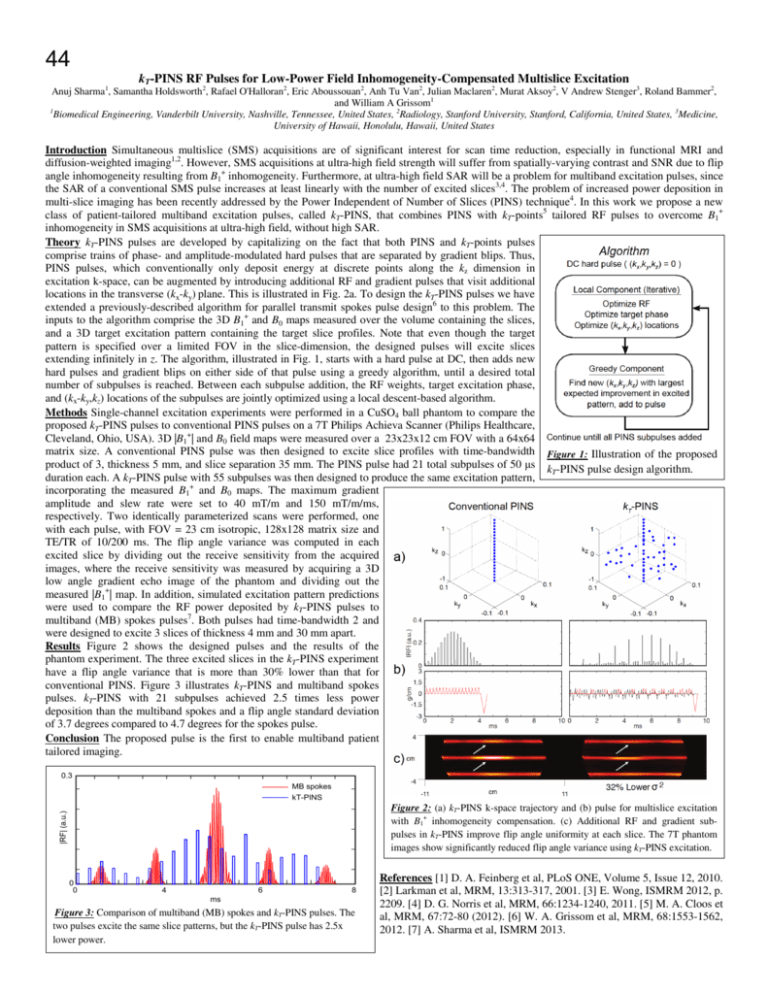
44 kT-PINS RF Pulses for Low-Power Field Inhomogeneity-Compensated Multislice Excitation Anuj Sharma1, Samantha Holdsworth2, Rafael O'Halloran2, Eric Aboussouan2, Anh Tu Van2, Julian Maclaren2, Murat Aksoy2, V Andrew Stenger3, Roland Bammer2, and William A Grissom1 1 Biomedical Engineering, Vanderbilt University, Nashville, Tennessee, United States, 2Radiology, Stanford University, Stanford, California, United States, 3Medicine, University of Hawaii, Honolulu, Hawaii, United States Introduction Simultaneous multislice (SMS) acquisitions are of significant interest for scan time reduction, especially in functional MRI and diffusion-weighted imaging1,2. However, SMS acquisitions at ultra-high field strength will suffer from spatially-varying contrast and SNR due to flip angle inhomogeneity resulting from B1+ inhomogeneity. Furthermore, at ultra-high field SAR will be a problem for multiband excitation pulses, since the SAR of a conventional SMS pulse increases at least linearly with the number of excited slices3,4. The problem of increased power deposition in multi-slice imaging has been recently addressed by the Power Independent of Number of Slices (PINS) technique4. In this work we propose a new class of patient-tailored multiband excitation pulses, called kT-PINS, that combines PINS with kT-points5 tailored RF pulses to overcome B1+ inhomogeneity in SMS acquisitions at ultra-high field, without high SAR. Theory kT-PINS pulses are developed by capitalizing on the fact that both PINS and kT-points pulses comprise trains of phase- and amplitude-modulated hard pulses that are separated by gradient blips. Thus, PINS pulses, which conventionally only deposit energy at discrete points along the kz dimension in excitation k-space, can be augmented by introducing additional RF and gradient pulses that visit additional locations in the transverse (kx-ky) plane. This is illustrated in Fig. 2a. To design the kT-PINS pulses we have extended a previously-described algorithm for parallel transmit spokes pulse design6 to this problem. The inputs to the algorithm comprise the 3D B1+ and B0 maps measured over the volume containing the slices, and a 3D target excitation pattern containing the target slice profiles. Note that even though the target pattern is specified over a limited FOV in the slice-dimension, the designed pulses will excite slices extending infinitely in z. The algorithm, illustrated in Fig. 1, starts with a hard pulse at DC, then adds new hard pulses and gradient blips on either side of that pulse using a greedy algorithm, until a desired total number of subpulses is reached. Between each subpulse addition, the RF weights, target excitation phase, and (kx-ky,kz) locations of the subpulses are jointly optimized using a local descent-based algorithm. Methods Single-channel excitation experiments were performed in a CuSO4 ball phantom to compare the proposed kT-PINS pulses to conventional PINS pulses on a 7T Philips Achieva Scanner (Philips Healthcare, Cleveland, Ohio, USA). 3D |B1+| and B0 field maps were measured over a 23x23x12 cm FOV with a 64x64 matrix size. A conventional PINS pulse was then designed to excite slice profiles with time-bandwidth Figure 1: Illustration of the proposed product of 3, thickness 5 mm, and slice separation 35 mm. The PINS pulse had 21 total subpulses of 50 s k -PINS pulse design algorithm. T duration each. A kT-PINS pulse with 55 subpulses was then designed to produce the same excitation pattern, + incorporating the measured B1 and B0 maps. The maximum gradient amplitude and slew rate were set to 40 mT/m and 150 mT/m/ms, respectively. Two identically parameterized scans were performed, one with each pulse, with FOV = 23 cm isotropic, 128x128 matrix size and TE/TR of 10/200 ms. The flip angle variance was computed in each excited slice by dividing out the receive sensitivity from the acquired images, where the receive sensitivity was measured by acquiring a 3D low angle gradient echo image of the phantom and dividing out the measured |B1+| map. In addition, simulated excitation pattern predictions were used to compare the RF power deposited by kT-PINS pulses to multiband (MB) spokes pulses7. Both pulses had time-bandwidth 2 and were designed to excite 3 slices of thickness 4 mm and 30 mm apart. Results Figure 2 shows the designed pulses and the results of the phantom experiment. The three excited slices in the kT-PINS experiment have a flip angle variance that is more than 30% lower than that for conventional PINS. Figure 3 illustrates kT-PINS and multiband spokes pulses. kT-PINS with 21 subpulses achieved 2.5 times less power deposition than the multiband spokes and a flip angle standard deviation of 3.7 degrees compared to 4.7 degrees for the spokes pulse. Conclusion The proposed pulse is the first to enable multiband patient tailored imaging. Figure 2: (a) kT-PINS k-space trajectory and (b) pulse for multislice excitation with B1+ inhomogeneity compensation. (c) Additional RF and gradient subpulses in kT-PINS improve flip angle uniformity at each slice. The 7T phantom images show significantly reduced flip angle variance using kT-PINS excitation. Figure 3: Comparison of multiband (MB) spokes and kT-PINS pulses. The two pulses excite the same slice patterns, but the kT-PINS pulse has 2.5x lower power. References [1] D. A. Feinberg et al, PLoS ONE, Volume 5, Issue 12, 2010. [2] Larkman et al, MRM, 13:313-317, 2001. [3] E. Wong, ISMRM 2012, p. 2209. [4] D. G. Norris et al, MRM, 66:1234-1240, 2011. [5] M. A. Cloos et al, MRM, 67:72-80 (2012). [6] W. A. Grissom et al, MRM, 68:1553-1562, 2012. [7] A. Sharma et al, ISMRM 2013.
